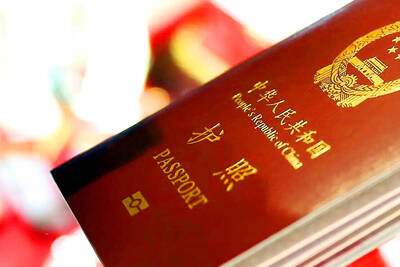China and Russia yesterday joined Iran in denouncing US sanctions, and backed efforts to restore a landmark nuclear deal with Tehran that US President Donald Trump abandoned in his first term and now wants to replace.
The three countries — all sanctioned by the US to varying degrees — stressed the need to end unilateral restrictions and urged the resumption of international talks over Iran’s atomic activities at a meeting in Beijing, a joint statement said.
Russia and China were key participants in the agreement signed during former US president Barack Obama’s administration that restricted Iran’s nuclear activity in exchange for sanctions relief, before Trump’s withdrawal in 2018.

Photo: AFP
As the standoff drags on, Iran has expanded its stocks of near-bomb grade enriched uranium, while Washington has toughened its sanctions.
Chinese Vice Minister of Foreign Affairs Ma Zhaoxu (馬朝旭) hosted yesterday’s meeting, which was also attended by Russian Deputy Minister of Foreign Affairs Sergei Ryabkov and his Iranian counterpart, Kazem Gharibabadi.
A separate meeting included Chinese Minister of Foreign Affairs Wang Yi (王毅).
“Political and diplomatic engagement and dialogue based on the principle of mutual respect remains the only viable and practical option,” Ma told reporters after the meeting.
Last week, Trump reiterated his interest in striking a new nuclear deal with Iran and warned the only alternative for the Islamic republic was to face military action.
The Beijing gathering follows a flurry of diplomatic activity on Iran’s nuclear program as world powers try to evade another crisis, at a time when wars in the Middle East and Ukraine are posing risks to energy prices and the global economy.
Iran has already had at least two rounds of preliminary nuclear talks with diplomats from the UK, France and Germany in Geneva in recent months. Trump also wrote a letter addressed to the Iranian leadership, which was received in Tehran on Wednesday via a top official from the United Arab Emirates.
The contents of the missive are not known and there has been no official response.
The participants in Beijing emphasized the need for all countries to abstain from actions that would undermine the inspection activities of the International Atomic Energy Agency monitors still working in Iran. The UN watchdog last month reported a surge in nuclear activity in Iran over the past few months.
“The situation has reached a critical juncture again. We must buy time for peace, resolve disputes through political and diplomatic means, and oppose the use of force and illegal sanctions,” Wang told reporters.

The Ministry of the Interior (MOI) is to tighten rules for candidates running for public office, requiring them to declare that they do not hold a Chinese household registration or passport, and that they possess no other foreign citizenship. The requirement was set out in a draft amendment to the Enforcement Rules of the Public Officials Election and Recall Act (公職人員選舉罷免法 ) released by the ministry on Thursday. Under the proposal, candidates would need to make the declaration when submitting their registration forms, which would be published in the official election bulletin. The move follows the removal of several elected officials who were

FOUR DESIGNATED AREAS: Notices were issued for live-fire exercises in waters south and northwest of Penghu, northeast of Keelung and west of Kaohsiung, they said The military is planning three major annual exercises across the army, navy and air force this month, with the navy’s “Hai Chiang” (海強, “Sea Strong”) drills running from today through Thursday, the Ministry of National Defense said yesterday. The Hai Chiang exercise, which is to take place in waters surrounding Taiwan, would feature P-3C Orion maritime patrol aircraft and S-70C anti-submarine helicopters, the ministry said, adding that the drills aim to bolster the nation’s offshore defensive capabilities. China has intensified military and psychological pressure against Taiwan, repeatedly sending warplanes and vessels into areas near the nation’s air defense identification zone and across

SENATE RECOMMENDATION: The National Defense Authorization Act encourages the US secretary of defense to invite Taiwan’s navy to participate in the exercises in Hawaii The US Senate on Thursday last week passed the National Defense Authorization Act (NDAA) for Fiscal Year 2026, which strongly encourages the US secretary of defense to invite Taiwan’s naval forces to participate in the Rim of the Pacific (RIMPAC) exercise, as well as allocating military aid of US$1 billion for Taiwan. The bill, which authorizes appropriations for the military activities of the US Department of Defense, military construction and other purposes, passed with 77 votes in support and 20 against. While the NDAA authorizes about US$925 billion of defense spending, the Central News Agency yesterday reported that an aide of US

NATIONAL DAY: The ‘Taiwan Dome’ would form the centerpiece of new efforts to bolster air defense and be modeled after Israel’s ‘Iron Dome,’ sources said President William Lai (賴清德) yesterday pledged to strengthen the nation’s air defense capabilities and build a “T-Dome” system to create a safety net against growing military threats from China. “We will accelerate our building of the T-Dome, establish a rigorous air defense system in Taiwan with multi-layered defense, high-level detection and effective interception, and weave a safety net for Taiwan to protect the lives and property of citizens,” he said in his National Day address. In his keynote address marking the Republic of China’s (ROC) 114th anniversary, Lai said the lessons of World War II have taught nations worldwide “to ensure that